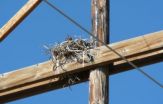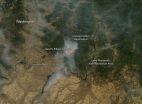(Press-News.org) VIDEO:
This is an animation of the growth and development of the extinct rangeomorph species Beothukis mistakenis, which lived during the Ediacaran Period from approximately 575 to 555 million years ago....
Click here for more information.
A bizarre group of uniquely shaped organisms known as rangeomorphs may have been some of the earliest animals to appear on Earth, uniquely suited to ocean conditions 575 million years ago. A new model devised by researchers at the University of Cambridge has resolved many of the mysteries around the structure, evolution and extinction of these 'proto animals.' The findings are reported today in the journal PNAS.
Rangeomorphs were some of the earliest large organisms on Earth, existing during a time when most other forms of life were microscopic in size. Most rangeomorphs were about 10 centimetres high, although some were up to two metres in height.
These creatures were ocean dwellers which lived during the Ediacaran period, between 635 and 541 million years ago. Their bodies were made up of soft branches, each with many smaller side branches, forming a geometric shape known as a fractal, which can be seen in many familiar branching shapes such as fern leaves and even river networks.
Rangeomorphs were unlike any modern organism, which has made it difficult to determine how they fed, grew or reproduced, and therefore difficult to link them to any particular modern group. However, despite the fact that they looked like plants, evidence points to the fact that rangeomorphs were actually some of the earliest animals.
"We know that rangeomorphs lived too deep in the ocean for them to get their energy through photosynthesis as plants do," said Dr Jennifer Hoyal Cuthill of Cambridge's Department of Earth Sciences, who led the research. "It's more likely that they absorbed nutrients directly from the sea water through the surface of their body. It would be difficult in the modern world for such large animals to survive only on dissolved nutrients."
"The oceans during the Ediacaran period were more like a weak soup – full of nutrients such as organic carbon, whereas today suspended food particles are swiftly harvested by a myriad of animals," said co-author Professor Simon Conway Morris.
Starting 541 million years ago, the conditions in the oceans changed quickly with the start of the Cambrian Explosion – a period of rapid evolution when most major animal groups first emerge in the fossil record and competition for nutrients increased dramatically.
Rangeomorphs have often been considered a 'failed experiment' of evolution as they died out so quickly once the Cambrian Explosion began in earnest, but this new analysis shows just how successful they once were.
Rangeomorphs almost completely filled the space surrounding them, with a massive total surface area. This made them very efficient feeders that were able to extract the maximum amount of nutrients from the ocean water.
"These creatures were remarkably well-adapted to their environment, as the oceans at the time were high in nutrients and low in competition," said Dr Hoyal Cuthill. "Mathematically speaking, they filled their space in a nearly perfect way."
Dr Hoyal Cuthill examined rangeomorph fossils from a number of locations worldwide, and used them to make the first computer reconstructions of the development and three-dimensional structure of these organisms, showing just how well-suited they were to their Ediacaran environment.
As the Cambrian Explosion began however, the rangeomorphs became 'sitting ducks', as they had no known means of defence from predators which were starting to evolve, and the changing chemical composition of the ocean meant that they could no longer get the nutrients they required to feed.
"As the Cambrian began, these Ediacaran specialists could no longer survive, and nothing quite like them has been seen again," said Dr Hoyal Cuthill.
INFORMATION:
Reconstructions show how some of the earliest animals lived -- and died
New three-dimensional reconstructions show how some of the earliest animals on Earth developed, and provide some answers as to why they went extinct
2014-08-11
ELSE PRESS RELEASES FROM THIS DATE:
A vaccine alternative protects mice against malaria
2014-08-11
A study led by Johns Hopkins Bloomberg School of Public Health researchers found that injecting a vaccine-like compound into mice was effective in protecting them from malaria. The findings suggest a potential new path toward the elusive goal of malaria immunization.
Mice, injected with a virus genetically altered to help the rodents create an antibody designed to fight the malaria parasite, produced high levels of the anti-malaria antibody. The approach, known as Vector immunoprophylaxis, or VIP, has shown promise in HIV studies but has never been tested with malaria, ...
Search for biomarkers aimed at improving treatment of painful bladder condition
2014-08-11
Winston-Salem, N.C. – August 11, 2014 – Taking advantage of technology that can analyze tissue samples and measure the activity of thousands of genes at once, scientists at Wake Forest Baptist Medical Center are on a mission to better understand and treat interstitial cystitis (IC), a painful and difficult-to-diagnose bladder condition.
"We are looking for molecular biomarkers for IC, which basically means we are comparing bladder biopsy tissue from patients with suspected interstitial cystitis to patients without the disease. The goal is to identify factors that will ...
Highly drug resistant, virulent strain of Pseudomonas aeruginosa arises in Ohio
2014-08-11
A team of clinician researchers has discovered a highly virulent, multidrug resistant form of the pathogen, Pseudomonas aeruginosa, in patient samples in Ohio. Their investigation suggests that the particular genetic element involved, which is still rare in the United States, has been spreading heretofore unnoticed, and that surveillance is urgently needed. The research is published ahead of print in Antimicrobial Agents and Chemotherapy.
The P. aeruginosa contained a gene for a drug resistant enzyme called a metallo beta-lactamase. Beta-lactamases enable broad-spectrum ...
Want to kill creativity of women in teams? Fire up the competition
2014-08-11
Recent research has suggested that women play better with others in small working groups, and that adding women to a group is a surefire way to boost team collaboration and creativity.
But a new study from Washington University in St. Louis finds that this is only true when women work on teams that aren't competing against each other. Force teams to go head to head and the benefits of a female approach evaporate.
"Intergroup competition is a double-edged sword that ultimately provides an advantage to groups and units composed predominantly or exclusively of men, while ...
New study: Ravens rule Idaho's artificial roosts
2014-08-11
A new study by the Wildlife Conservation Society (WCS), U.S. Geological Survey (USGS) and Idaho State University (ISU) explored how habitat alterations, including the addition of energy transmission towers, affect avian predators nesting in sagebrush landscapes.
Researchers compared nesting habitat selection between Common Ravens and three raptor species commonly found in sagebrush ecosystems: Red-tailed Hawks, Swainson's Hawks, and Ferruginous Hawks.
Using the data from their field research and reviewing historical data from other studies, the scientists developed ...
Can fiction stories make us more empathetic?
2014-08-11
Empathy is important for navigating complex social situations, and is considered a highly desirable trait. Raymond Mar, a psychologist at York University in Canada, discussed how exposure to narrative fiction may improve our ability to understand what other people are thinking or feeling in his session at the American Psychological Association's 122nd Annual Convention.
Exposure to stories
Many stories are about people--their mental states, their relationships—even stories with inanimate objects, may have human-like characteristics. Mar explains that we understand stories ...
Julio embarking on weakening trend
2014-08-11
The Central Pacific Hurricane Center has issued its 30th warning on Julio today at 1500 GMT. Julio's position at this point is 395 miles northeast of Honolulu, Hawaii moving northwest at 8 knots per hour. Julio is moving toward the northwest near 9 mph, 15 km/h. Maximum sustained winds are near 75 mph, 120 km/h, with higher gusts. Julio is expected to weaken slightly over the next 48 hours, down to tropical storm strength by tonight.
At present, hurricane force winds extend outward up to 25 miles, 35 km, from the center, and tropical storm force winds extend outward ...
Genevieve Downgraded to a tropical storm
2014-08-11
Once Super Typhoon Genevieve has now been downgraded to a tropical storm. The storm is located approximately 819 nautical miles west-northwest of Midway Island. It is currently tracking northwestward at 8 knots per hour over the past six hours. Maximum significant wave height is 32 feet. Maximum sustained winds 70 knots gusting to 85 knots, with winds of 34 knots or higher occur within 80 to 105 miles of the cente,r and winds of 64 knots or higher occur within 15 miles of the center. No landmasses are currently threatened by this storm.
Genevieve is moving northwest ...
Southfork and Staley Complex fires in Oregon
2014-08-11
The Southfork Complex fire began with a lightning strike on July 31, 2014. The complex of Murderers Creek South fire and the Buck Fork fire is located 20 miles southwest of John Day, Oregon and has affected 62,476 acres to date. The fire area experienced a shift in direction of the prevailing winds Sunday. There were short up-slope, up-canyon runs. At present there are 798 personnel fighting this fire complex.
Projected outlook for this fire complex in the next twelve hours sees continued fire spread to to the north toward Dayville, Oregon as well as continued fire ...
Devil's Elbow Complex in Washington state
2014-08-11
The Devil's Elbow Complex is four wildfires that are located on the Colville Indian Reservation in northeastern Washington. They were detected on August 3, but were likely ignited by lightning that passed through the area on August 2.
Three fires are in the San Poil River Valley, approximately 10-12 miles north of the town of Keller, WA. These are the Cub Creek Fire (165), the Central Peak Fire (160), and the Deadhorse Fire (164). They are burning timber, grass, brush, litter, and heavy slash that resulted from a local wind storm two years ago. The terrain is very steep ...
LAST 30 PRESS RELEASES:
Statins significantly reduce mortality risk for adults with diabetes, regardless of cardiovascular risk
Brain immune cells may drive more damage in females than males with Alzheimer’s
Evidence-based recommendations empower clinicians to manage epilepsy in pregnancy
Fungus turns bark beetles’ defenses against them
There are new antivirals being tested for herpesviruses. Scientists now know how they work
CDI scientist, colleagues author review of global burden of fungus Candida auris
How does stroke influence speech comprehension?
B cells transiently unlock their plasticity, risking lymphoma development
Advanced AI dodel predicts spoken language outcomes in deaf children after cochlear implants
Multimodal imaging-based cerebral blood flow prediction model development in simulated microgravity
Accelerated streaming subgraph matching framework is faster, more robust, and scalable
Gestational diabetes rose every year in the US since 2016
OHSU researchers find breast cancer drug boosts leukemia treatment
Fear and medical misinformation regarding risk of progression or recurrence among patients with breast cancer
Glucagonlike peptide-1 receptor agonists and asthma risk in adolescents with obesity
Reviving dormant immunity: Millimeter waves reprogram the immunosuppressive microenvironment to potentiate immunotherapy without obvious side effects
Safety decision-making for autonomous vehicles integrating passenger physiological states by fNIRS
Fires could emit more air pollution than previously estimated
A new way to map how cells choose their fate
Numbers in our sights affect how we perceive space
SIMJ announces global collaborative book project in commemoration of its 75th anniversary
Air pollution exposure and birth weight
Obstructive sleep apnea risk and mental health conditions among older adults
How talking slows eye movements behind the wheel
The Ceramic Society of Japan’s Oxoate Ceramics Research Association launches new international book project
Heart-brain connection: international study reveals the role of the vagus nerve in keeping the heart young
Researchers identify Rb1 as a predictive biomarker for a new therapeutic strategy in some breast cancers
Survey reveals ethical gaps slowing AI adoption in pediatric surgery
Stimulant ADHD medications work differently than thought
AI overestimates how smart people are, according to HSE economists
[Press-News.org] Reconstructions show how some of the earliest animals lived -- and diedNew three-dimensional reconstructions show how some of the earliest animals on Earth developed, and provide some answers as to why they went extinct








